|
Research Projects
New materials drive innovations in energy generation and storage, medicine, environmental remediation, and countless other areas that impact our daily lives. Our group thrives on the design and discovery of new materials and developing the science for precisely controlling and understanding their structure, properties, and function. Our research encompasses organic and inorganic synthesis, coordination chemistry, solid-state chemistry, biomolecule assembly, and nanoparticle synthesis and assembly. Each research project is based on hypotheses related to material design, structure, and function and aims to uncover and ultimately control, at the atomic and molecular level, new and useful chemical and physical phenomena. We are not only motivated to discover and develop logical synthetic strategies for creating new materials, but also to translate unique material properties to practical applications. |
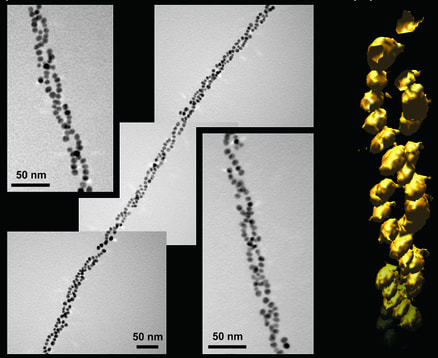
Assembly and Emergent Properties of Nanoparticle Superstructures
The properties of nanoparticles depend on their size, shape, composition, and assembly. We have pioneered the development of peptide-based methods for controlling the synthesis and assembly of nanoparticles into structurally complex 0-,1-, and 2-D architectures. We are refining and expanding the scope of this methodology and using it to address fundamental questions regarding structure-property relationships in this class of materials. We are particularly interested in constructing chiral nano materials and nanoparticle assemblies and controlling and fine-tuning their plasmonic chiroptical properties. The chiral double-helical gold nanoparticle superstructure shown in the graphic on the left was one of the first chiral nanoparticle assemblies reported (2008). This work illustrated for the first time how chiral nanoparticle superstructures could be fabricated with exceptional precision, a key factor that underscores their potential for exhibiting measurable and well-defined plasmonic chiroptical properties.
Leading Publications:
The properties of nanoparticles depend on their size, shape, composition, and assembly. We have pioneered the development of peptide-based methods for controlling the synthesis and assembly of nanoparticles into structurally complex 0-,1-, and 2-D architectures. We are refining and expanding the scope of this methodology and using it to address fundamental questions regarding structure-property relationships in this class of materials. We are particularly interested in constructing chiral nano materials and nanoparticle assemblies and controlling and fine-tuning their plasmonic chiroptical properties. The chiral double-helical gold nanoparticle superstructure shown in the graphic on the left was one of the first chiral nanoparticle assemblies reported (2008). This work illustrated for the first time how chiral nanoparticle superstructures could be fabricated with exceptional precision, a key factor that underscores their potential for exhibiting measurable and well-defined plasmonic chiroptical properties.
Leading Publications:
For more details, see the following papers on the 'Publications' page:
130,122,119,114,99,95,92,87,74,72,68,64,56,54,48,44,36,35,29,26,25,24,22,16
130,122,119,114,99,95,92,87,74,72,68,64,56,54,48,44,36,35,29,26,25,24,22,16
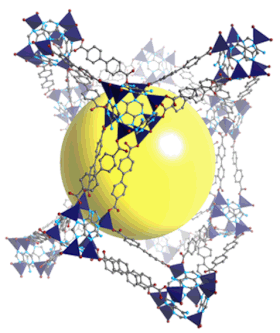
Biomolecule-Based Metal-Organic Frameworks (bio-MOFs)
The group has broad interests in metal-organic framework (MOF) chemistry. For some potential applications, it is important to consider not only MOF function but also MOF composition. We have led the development of biomolecule-based MOFs (bio-MOFs) and explored their potential for drug delivery and molecular separations. Our particular focus in this area has been on the design and construction of adenine-based MOFs. This research has led to the emergence of new classes of microporous and mesoporous MOFs with complex and highly tunable multicomponent molecular architectures.
Leading Publications:
The group has broad interests in metal-organic framework (MOF) chemistry. For some potential applications, it is important to consider not only MOF function but also MOF composition. We have led the development of biomolecule-based MOFs (bio-MOFs) and explored their potential for drug delivery and molecular separations. Our particular focus in this area has been on the design and construction of adenine-based MOFs. This research has led to the emergence of new classes of microporous and mesoporous MOFs with complex and highly tunable multicomponent molecular architectures.
Leading Publications:
For more details, see the following papers on the 'Publications' page:
118,117,111,102,100,73,65,63,53,43,41,39,37,34,32,30,28,27,23,21,18,17
118,117,111,102,100,73,65,63,53,43,41,39,37,34,32,30,28,27,23,21,18,17
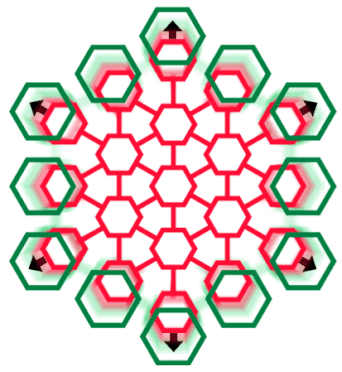
Structural and Functional Domains in MOFs
Complex functional systems, including living cells and engineered systems, have multiple different functional domains and mechanisms for controlling the directional transport of matter between these domains. These systems provide inspiration for us as we address the challenge of constructing MOFs with multiple different components, compartments, and domains and controlling the directional flow and diffusion of molecules through such MOFs. We are developing new strategies for controlling the hierarchical structure of MOFs that will enable control over the diffusion of molecules and the placement of molecules and nanoscale structures within MOF scaffolds. We recently introduced the concepts of 'Domain Building Blocks' in MOFs as well as gradients of structure and function in MOFs.
Leading Publications:
Complex functional systems, including living cells and engineered systems, have multiple different functional domains and mechanisms for controlling the directional transport of matter between these domains. These systems provide inspiration for us as we address the challenge of constructing MOFs with multiple different components, compartments, and domains and controlling the directional flow and diffusion of molecules through such MOFs. We are developing new strategies for controlling the hierarchical structure of MOFs that will enable control over the diffusion of molecules and the placement of molecules and nanoscale structures within MOF scaffolds. We recently introduced the concepts of 'Domain Building Blocks' in MOFs as well as gradients of structure and function in MOFs.
Leading Publications:
For more details, see the following papers on the 'Publications' page:
132,121,120,115,102,86,81,65,63,53,37
132,121,120,115,102,86,81,65,63,53,37
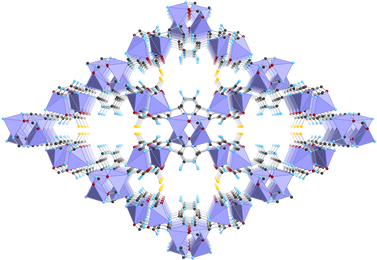
MOFs for Separations and Clean Energy
Industrial molecular separations are highly energy intensive and novel strategies for reducing the costs associated with these separations are critically important. We are developing new classes of MOFs that meet this need, with a specific focus on controlling and tailoring the structures of these materials to control their sorption properties. Of particular interest are MOF materials with multiple structural domains, including core-shell MOFs and stratified MOFs (sMOFs). Through ongoing collaborations with the National Energy Technology Laboratory (NETL), we are actively engaged in interfacing MOF materials with polymers to create new mixed matrix membrane materials. Our early work in this area demonstrated for the first time the importance and effects of functionalizing the exterior surfaces of MOF particles to improve membrane properties and performance.
Leading Publications:
Industrial molecular separations are highly energy intensive and novel strategies for reducing the costs associated with these separations are critically important. We are developing new classes of MOFs that meet this need, with a specific focus on controlling and tailoring the structures of these materials to control their sorption properties. Of particular interest are MOF materials with multiple structural domains, including core-shell MOFs and stratified MOFs (sMOFs). Through ongoing collaborations with the National Energy Technology Laboratory (NETL), we are actively engaged in interfacing MOF materials with polymers to create new mixed matrix membrane materials. Our early work in this area demonstrated for the first time the importance and effects of functionalizing the exterior surfaces of MOF particles to improve membrane properties and performance.
Leading Publications:
For more details, see the following papers on the 'Publications' page:
121,120,117,115,102,98,91,90,89,86,73,69,49,43,41,37,34,23,21,18
121,120,117,115,102,98,91,90,89,86,73,69,49,43,41,37,34,23,21,18
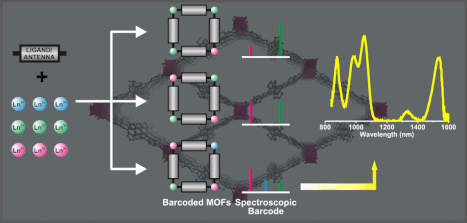
NIR Luminescent MOFs as Barcodes and Markers for Bioanalysis
We are developing new classes of spectroscopic barcoded materials, bioanalytical markers, and sensors based on lanthanide-containing MOFs. We are particularly interested in NIR-emitting MOFs for biological imaging. We have introduced novel classes of Ln-based MOFs and pioneered new methods for controlling and fine-tuning their luminescence properties. Using these methods, we have developed MOFs that both absorb and emit at frequencies ideal for biological imaging.
Leading Publications:
We are developing new classes of spectroscopic barcoded materials, bioanalytical markers, and sensors based on lanthanide-containing MOFs. We are particularly interested in NIR-emitting MOFs for biological imaging. We have introduced novel classes of Ln-based MOFs and pioneered new methods for controlling and fine-tuning their luminescence properties. Using these methods, we have developed MOFs that both absorb and emit at frequencies ideal for biological imaging.
Leading Publications:
For more details, see the following papers on the 'Publications' page:
97,96,83,81,70,40,28,27,20,19,17
97,96,83,81,70,40,28,27,20,19,17
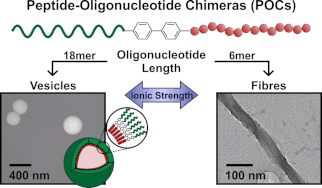
Morphologically Tunable Biomolecule-Based Soft Materials
We are interested in building programmable soft materials using hybrid peptide-organic-oligonucleotide bimolecular constructs: peptide-oligonucleotide chimeras (POCs). These materials can be designed to undergo morphological transformations in response to environmental cues. We are identifying design rules that govern the assembly of these unique bimolecular constructs and exploring their applications.
For more details, see the following papers on the 'Publications' page:
76
We are interested in building programmable soft materials using hybrid peptide-organic-oligonucleotide bimolecular constructs: peptide-oligonucleotide chimeras (POCs). These materials can be designed to undergo morphological transformations in response to environmental cues. We are identifying design rules that govern the assembly of these unique bimolecular constructs and exploring their applications.
For more details, see the following papers on the 'Publications' page:
76
Funding and support for these projects is/was provided by the Defense Advance Research Projects Agency, the Defense Threat Reduction Agency, the National Science Foundation, the Air Force Office of Scientific Research, the Department of Energy (via the National Energy Technology Laboratory's Regional University Alliance, the University Coalition for Fossil Energy Research, and BES), the American Chemical Society (PRF), the Argonne National Laboratory Center for Nanomaterials, and the University of Pittsburgh.
